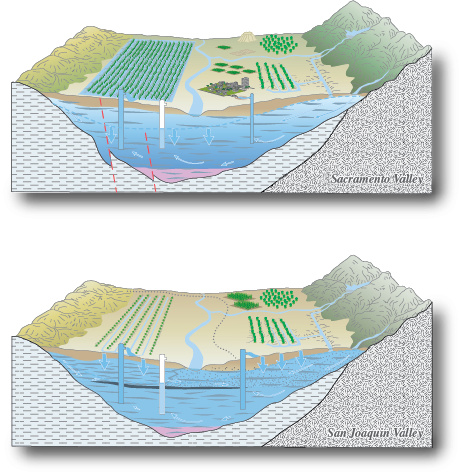California's Central Valley
Central Valley Hydrologic Model (CVHM)
In an effort to aid water managers in understanding how water moves through the aquifer system, predicting water-supply scenarios, and addressing issues related to water competition, the USGS developed a new hydrologic modeling tool, the Central Valley Hydrologic Model (CVHM). The CVHM is an extensive, detailed three-dimensional (3D) computer model of the hydrologic system of the Central Valley (Faunt, 2009). The Central Valley Hydrologic Model (CVHM) simultaneously accounts for changing water supply and demand across the landscape, and simulates surface water and groundwater flow across the entire Central Valley.

Post-development hydrogeology of the Sacramento and San Joaquin Valleys, California.
Benefits to California Water Managers
The CVHM helps to address water competition issues such as:
- Conjunctive water use (interdependent use of surface water and groundwater)
- Conservation of agricultural land
- Land-use change, including environmental concerns and urbanization, and its effects on water resources
- Effects of climate change
CVHM Components
Geospatial Database
A Geographic Information System (GIS) was used to compile, manage, store, and analyze the large quantities of data in the geospatial database needed to run the model, and to understand and visualize the data output.
Get the DataTexture Model
The texture model is key to understanding how water moves through the Central Valley groundwater system. Scientists developed the geologic texture model to describe the coarseness or fineness of valley-fill materials that make up the aquifer system, and then used it to estimate hydraulic properties for every cell in the model grid. To create the model, lithologic data from approximately 8,500 drillers' logs of boreholes ranging in depth from 12 to 3,000 feet below land surface, along with other information, were compiled and analyzed.
Texture Model DetailsFarm Process
The complex hydrologic system of the Central Valley is simulated using the USGS hydrologic modeling software, MODFLOW. Combined with the Farm Process, MODFLOW simulates natural and human-induced water movement and consumption over the landscape and accounts for supply-constrained and demand-driven conjunctive use of surface and groundwater in agricultural, urban, and natural settings. For the Central Valley, the tool simulates unmetered historical pumping and surface-water deliveries for 21 water-balance regions for water years 1962 to 2003.
Learn MoreNumerical Model
A numerical groundwater-flow model capable of being accurate at scales relevant to water-management decisions was developed for the Central Valley, California.
Learn More
 Model Datasets:
Model Datasets: Numerical Model Data files:
Numerical Model Data files: Texture Model Data files:
Texture Model Data files: